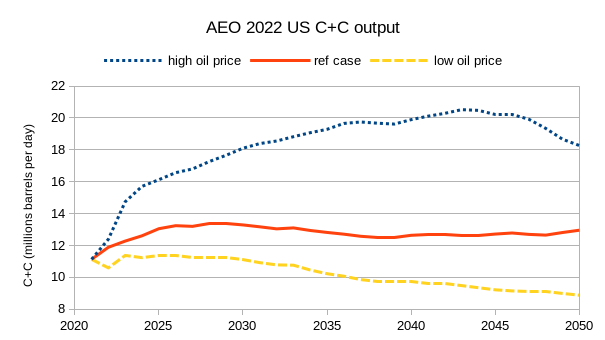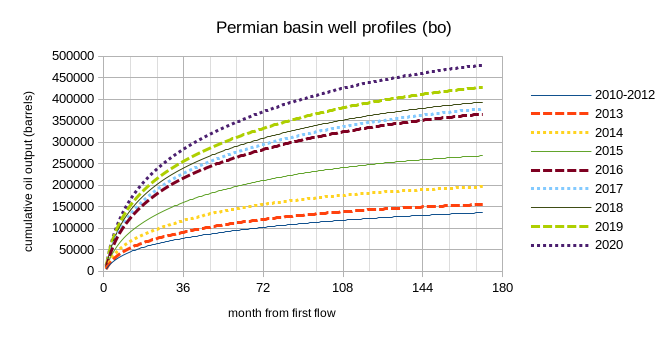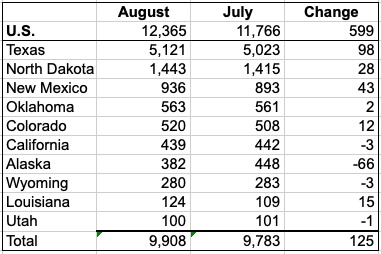The US Energy Information Administration (EIA) published its Annual Energy Outlook (AEO) 2022 on March 3.

The US Energy Information Administration (EIA) published its Annual Energy Outlook (AEO) 2022 on March 3.

Much of the information for this post comes from data at shaleprofile , and assessments by the USGS. In addition a paper published in Jan 2022 by Wardana Saputra et al was an excellent resource.
The basic method used in the is analysis is covered in an earlier post, essentially the convolution of average well profiles with the monthly completion rate over time is used to model future output. I focus on the period starting in Jan 2010 and consider only horizontal tight oil wells in the analysis. Future well profiles are estimated and several future scenarios for completion rate are used, clearly the future is unknown so future completion rates and estimated ultimate recovery (EUR) for wells completed in the future can only be guessed at.
In order to make such a guess I start with the USGS assessments for the Permian basin where the mean estimate for prospective net acres as of mid 2017 was about 50 million acres. I use an estimate for average acres per well of 300 acres (about 9500 feet lateral length with spacing of 1320 feet between laterals) which gives an estimate of about 167 thousand wells. There were about 14 thousand wells already completed in the Permian basin by June 2017 so total completions would be about 181 thousand wells, if oil prices were high enough to make every potential well location profitable. Using the mean UTRR estimate (70 Gb) and number of potential drilling locations (about 160 thousand as of Dec 21, 2021 based on the data at shale profile where about 21 thousand wells were completed from July 2017 to Dec 2021), I find and estimate for the future decrease in EUR per well that will result in a UTRR of 70 Gb if all potential wells were completed.
After that step a discounted cash flow analysis using guesses of future costs and prices is used to determine whether a well will be profitable to complete to arrive at an ERR for a given scenario, typically ERR is less than TRR, but in rare high oil price scenarios they could be nearly equal.
Average well profiles have been developed by fitting an Arps hyperbolic function to the data from shaleprofile.com for the average 2010 to 2012 well and then for each individual year from 2013 to 2020. In my scenarios I assume EUR starts to decrease after Dec 2020 and assume no further increase in lateral length or change in average well spacing.

The North Dakota area of the Bakken LTO basin has accessible data from the ND Department of Natural Resources, Oil and Gas Division. Production here seems to be past peak and in general decline. The data presented here is therefore more a historical perspective than of much interest in predicting issues that may have significant impact for the future. However it may give some indication on what to expect in the Permian basins, the only ones left in the US that may have capacity to increase production. The Texas RRC does also produce good data but a global data dump produces files that are too big for my computer to handle and splitting into smaller subsets is too man-hour intensive for me to pursue.
These charts show how the oil production has changed every three years by range (almost equivalent to lines of longitudes) and township lines (latitudes). These lines run every six miles and the area they contain is called a township, consisting of 36 square mile sections (that’s the simplified explanation, earth’s curvature and irregular land features make things a bit more complicated).


The future of tight oil output in the US will depend in large part on future development of Permian Basin resources in Texas and New Mexico. I have developed nine scenarios for future Permian basin tight oil output based on 3 levels of technically recoverable resources (TRR) and 3 different future oil price scenarios. These are summarized in the chart below.

All data for this post is from the EIA’s Petroleum Supply Monthly
The charts below are primarily for the largest US oil producing states (>100 kb/d) and are updated to August 2019. If you are interested in additional states, let it be known.
Ron has asked if I would take over the monthly posts for USA oil production. I have tentatively agreed to do that. Let us all thank Ron for his work at tracking US production and for his insights. Ron will continue to monitor what’s happening with US production and provide his comments. He is not going away.
This is my first post on US production by state. If you spot any errors, please let me know and I will try to fix them.
